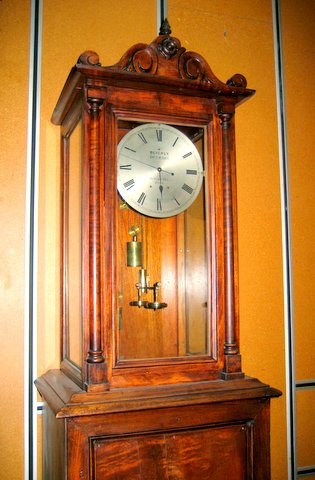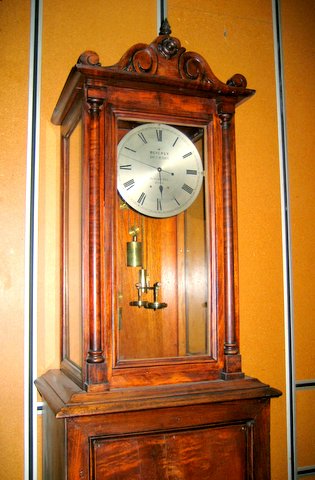For centuries, inventors have been pursuing the concept of a perpetual motion machine—a device that generates its own power and, like the Energizer Bunny on TV commercials, keeps “going, and going, and going…” Here are two real-life objects that are doing just that. (This story is a sneak peek from our 30th annual edition, Uncle John’s Old Faithful Bathroom Reader, available November 2017.)

What It Is: A mechanical “weight-driven” clock—similar to a grandfather clock—that has never needed winding since it was first wound in 1864.
Details: Arthur Beverly (1822–1907) was a Scottish-born clockmaker, mathematician, and astronomer who emigrated to New Zealand in 1857. He built his famous clock for the New Zealand Exhibition of 1865.
Ordinary weight-driven clocks are powered by a weight hanging from a chain. The chain is wrapped around a cylinder called a drum, and as gravity pulls on the weight, the chain causes the drum to turn.
The drum is connected to an assembly of gears that connect to the hour and minute hands of the clock: When the drum turns, the gearwheels move, and that causes the hour and minute hands to move, which is how the clock tells time.
Over a given period of time, the action of the clock causes the chain to unwind from the drum. And as it unwinds, the weight sinks lower and lower inside the clock. Eventually an ordinary weight-driven clock will have to be manually wound, usually by inserting a key into the face of the clock and turning the key. Doing so rotates the drum in the reverse direction, winding the chain back around the drum and lifting the weight higher inside the clock.
Changing Time: Beverly’s clock is different. It has never needed winding because it winds itself. The clock contains a sealed, airtight box containing about a cubic foot of air. A diaphragm is attached to the box, and as the air inside the box expands or contracts due to changes in air temperature or atmospheric pressure, the diaphragm moves. It moves outward when the air in the box expands, and inward when it contracts.
The movement of the diaphragm is the mechanism that winds the clock. A difference of as little as 6°F during the day will move the diaphragm enough to lift the weight one inch inside the clock, which is enough to keep the clock ticking the entire day. Result: The clock has run almost continuously since Beverly first wound it up in 1864, more than 150 years ago. The only times the clock has stopped ticking are 1) when its owner, the Physics Department of the University of Otago, in Dunedin, New Zealand, stops it deliberately in order to clean, move, or repair it; or 2) on those rare days when the difference in temperature between the hottest and coldest part of the day is less than 6°F. On such occasions the clock does stop, but only temporarily: as soon as the temperature begins to change the clock starts working again, without needing to be wound. Arthur Beverly is the only person who ever wound the clock, and he only wound it once.
If you ever have an opportunity to visit Dunedin, on the South Island of New Zealand, be sure to drop by the University of Otago and have a look at the Beverly Clock. It’s on display on the third floor of the Physics Department building near the elevator. And if you can’t get to New Zealand for 10, 20, or perhaps even 50 years or more, don’t worry. It’s a pretty safe bet the Beverly Clock will still be ticking away when you get there.
The Oxford Electric Bell
What It Is: A battery-powered bell that has been ringing continuously on the same set of batteries since 1840. The device is on public display near the main entrance of Oxford’s Clarendon Library.
Details: An Oxford University physics professor named Robert Walker bought the device in 1840 from Watkins and Hill, a London firm that made scientific instruments. The device consists of two brass bells less than an inch apart. The bells are mounted on vertical brass rods, and above each bell is a battery, which looks like a candlestick. A tiny metal sphere suspended on a silk thread between the batteries serves as the clapper that rings the bells.
When the sphere touches the first bell, it completes an electrical circuit that gives that bell an electrostatic charge. This charge repels the sphere, pushing it away from the first bell toward the second bell.
When the sphere touches the second bell, that bell becomes charged and repels the sphere back toward the first bell.
Huh?! This sequence of events has been repeating itself since the bell was set up in 1840. It’s estimated that the bells have rung some 10 billion times since then. Ironically, because the device is protected by its own glass cover and sits inside a glass display case, the bells can be seen ringing, but they cannot be heard.
No one knows how much longer the bells will ring. That depends on what the batteries are made of, and no one knows for sure. The curious are left to wait for the batteries to die before they can be taken apart to see what’s in them. They’ve waited more than 170 years already and may have centuries more to go.









